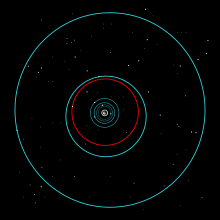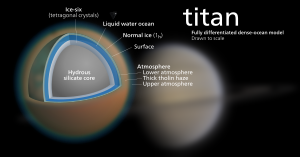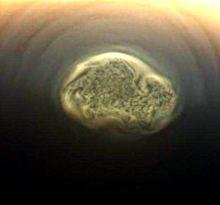EditWatch this pageRead in another language
Titan (moon)
Not to be confused with Titania (moon) or Triton (moon).
Titan in natural color. The thick atmosphere is orange due to a dense organonitrogen haze.
DiscoveryDiscovered byChristiaan HuygensDiscovery dateMarch 25, 1655DesignationsPronunciation i/ˈtaɪtən/
i/ˈtaɪtən/
Saturn VIAdjectivesTitanean, Titanian[1]Orbital characteristics[2]Periapsis1186680 kmApoapsis1257060 km
1221870 kmEccentricity0.0288
15.945 d
Average orbital speed
5.57 km/s (calculated)Inclination0.34854° (to Saturn's equator)Satellite ofSaturnPhysical characteristics
Mean radius
2575.5±2.0 km (0.404 Earths,[3]1.480 Moons)
8.3×107 km2 (0.163 Earths)Volume7.16×1010 km3 (0.066 Earths) (3.3 Moons)Mass(1.3452±0.0002)×1023 kg
(0.0225 Earths)[3] (1.829 Moons)
Mean density
1.8798±0.0044 g/cm3[3]
1.352 m/s2 (0.14 g) (0.85 Moons)
0.3414±0.0005[4]
2.639 km/s (1.11 Moons)
Synchronous
ZeroAlbedo0.22[5]Temperature93.7 K (−179.5 °C)[6]
8.2[7] to 9.0Atmosphere
Surface pressure
146.7 kPa (1.45 atm)Composition by volumeVariable[8][9]
Stratosphere:
98.4% nitrogen (N2),
1.4% methane (CH4),
0.2% hydrogen (H2);
Lower troposphere:
95.0% N2, 4.9% CH4
Titan is the largest moon of Saturn. It is the only moon known to have a denseatmosphere,[10] and the only object in space other than Earth where clear evidence of stable bodies of surface liquid has been found.[11]
Titan is the sixth ellipsoidal moon fromSaturn. Frequently described as a planet-like moon, Titan's diameter is 50% larger than Earth's natural satellite, the Moon, and it is 80% more massive. It is the second-largest moon in the Solar System, after Jupiter's moon Ganymede, and is larger than the smallest planet, Mercury, although only 40% as massive. Discovered in 1655 by the Dutch astronomer Christiaan Huygens,[12][13] Titan was the first known moon of Saturn, and the sixth known planetary satellite.[14] Titan orbits Saturn at 20 Saturn radii. From Titan's surface Saturn subtends an arc of 5.7 degrees and would appear 11.4 times the size our moon does to us.
Titan is primarily composed of water ice and rocky material. Much as with Venus before the Space Age, the dense opaque atmosphere prevented understanding of Titan's surface until new information accumulated when theCassini–Huygens mission arrived in 2004, including the discovery of liquid hydrocarbonlakes in Titan's polar regions. The geologically young surface is generally smooth, with fewimpact craters, although mountains and several possible cryovolcanoes have been found.[15][16]
The atmosphere of Titan is largely nitrogen; minor components lead to the formation ofmethane and ethane clouds and nitrogen-rich organic smog. The climate—including wind and rain—creates surface features similar to those of Earth, such as dunes, rivers, lakes, seas (probably of liquid methane and ethane), and deltas, and is dominated by seasonal weather patterns as on Earth. With its liquids (both surface and subsurface) and robust nitrogen atmosphere, Titan's methane cycle is analogous to Earth's water cycle, although at the much lower temperature of about 94 K (−179.2 °C).
HistoryEdit
Christiaan Huygensdiscovered Titan in 1655.
Titan was discovered on March 25, 1655 by the Dutch astronomer Christiaan Huygens. Huygens was inspired by Galileo's discovery of Jupiter's four largest moons in 1610 and his improvements in telescope technology. Christiaan, with the help of his brotherConstantijn Huygens, Jr., began building telescopes around 1650 and discovered the first observed moon orbiting Saturn with one of the telescopes they built.[17]
He named it simply Saturni Luna (or Luna Saturni, Latin for "Saturn's moon"), publishing in the 1655 tract De Saturni Luna Observatio Nova (A New Observation of Saturn's Moon). After Giovanni Domenico Cassini published his discoveries of four more moons of Saturn between 1673 and 1686, astronomers fell into the habit of referring to these and Titan as Saturn I through V (with Titan then in fourth position). Other early epithets for Titan include "Saturn's ordinary satellite".[18] Titan is officially numbered Saturn VI because after the 1789 discoveries the numbering scheme was frozen to avoid causing any more confusion (Titan having borne the numbers II and IV as well as VI). Numerous small moons have been discovered closer to Saturn since then.
The name Titan, and the names of all seven satellites of Saturn then known, came fromJohn Herschel (son of William Herschel, discoverer of Mimas and Enceladus) in his 1847 publication Results of Astronomical Observations Made at the Cape of Good Hope.[19] He suggested the names of the mythological Titans (Ancient Greek: Τῑτάν), brothers and sisters of Cronus, the Greek Saturn. In Greek mythology, the Titans were a race of powerful deities, descendants of Gaiaand Uranus, that ruled during the legendaryGolden Age.
Orbit and rotationEdit
Titan's orbit (highlighted in red) among the other large inner moons of Saturn. The moons outside its orbit are (from the outside to the inside) Iapetus and Hyperion; those inside are Rhea, Dione, Tethys, Enceladus, and Mimas.
Titan orbits Saturn once every 15 days and 22 hours. Like the Moon and many of the satellites of the giant planets, its rotational period (its day) is identical to its orbital period; Titan is thus tidally locked in synchronous rotation with Saturn, and permanently shows one face to the planet. Because of this, there is a sub-Saturnian point on its surface, from which the planet would always appear to hang directly overhead. Longitudes on Titan are measured westward, starting from the meridian passing through this point.[20] Its orbital eccentricity is 0.0288, and the orbital plane is inclined 0.348 degrees relative to the Saturnian equator.[2] Viewed from Earth, Titan reaches an angular distance of about 20 Saturn radii (just over 1,200,000 kilometres (750,000 mi)) from Saturn and subtends a disk 0.8 arcseconds in diameter.
The small, irregularly shaped satelliteHyperion is locked in a 3:4 orbital resonancewith Titan. A "slow and smooth" evolution of the resonance—in which Hyperion would have migrated from a chaotic orbit—is considered unlikely, based on models. Hyperion probably formed in a stable orbital island, whereas the massive Titan absorbed or ejected bodies that made close approaches.[21]
Bulk characteristicsEdit
Size comparison: Titan (lower left) with the Moon and Earth (top and right)
A model of Titan's internal structure
Titan is 5,151 kilometres (3,201 mi) in diameter,[3] 1.06 times that of the planet Mercury, 1.48 that of the Moon, and 0.40 that of Earth. Before the arrival of Voyager 1 in 1980, Titan was thought to be slightly larger than Ganymede (diameter 5,262 kilometres (3,270 mi)) and thus the largest moon in the Solar System; this was an overestimation caused by Titan's dense, opaque atmosphere, which extends many kilometres above its surface and increases its apparent diameter.[22] Titan's diameter and mass (and thus its density) are similar to those of the Jovian moons Ganymede and Callisto.[23]Based on its bulk density of 1.88 g/cm3, Titan's bulk composition is half water ice and half rocky material. Though similar in composition to Dione and Enceladus, it is denser due to gravitational compression. It has a mass equal to 1/4226 of Saturn, making it the largest moon of the gas giants relative to the mass of its primary, although at 1/22.609 of Saturn's diameter, Triton is larger relative in diameter to Neptune at 1/18.092 of Neptune's diameter.
Titan is likely differentiated into several layers with a 3,400-kilometre (2,100 mi) rocky center surrounded by several layers composed of different crystalline forms of ice.[24] Its interior may still be hot enough for a liquid layer consisting of a "magma" composed of water and ammonia between the ice Ih crust and deeper ice layers made of high-pressure forms of ice. The presence of ammonia allows water to remain liquid even at a temperature as low as 176 K (−97 °C) (foreutectic mixture with water).[25] Cassini probe discovered the evidence for the layered structure in the form of natural extremely-low-frequency radio waves in Titan's atmosphere. Titan's surface is thought to be a poor reflector of extremely-low-frequency radio waves, so they may instead be reflecting off the liquid–ice boundary of a subsurface ocean.[26] Surface features were observed by the Cassini spacecraft to systematically shift by up to 30 kilometres (19 mi) between October 2005 and May 2007, which suggests that the crust is decoupled from the interior, and provides additional evidence for an interior liquid layer.[27] Further supporting evidence for a liquid layer and ice shell decoupled from the solid core comes from the way the gravity field varies as Titan orbits Saturn.[28] Comparison of the gravity field with the RADAR-based topography observations[29]also suggests that the ice shell may be substantially rigid.[30][31]
FormationEdit
The moons of Jupiter and Saturn are thought to have formed through co-accretion, a similar process to that believed to have formed the planets in the Solar System. As the young gas giants formed, they were surrounded by discs of material that gradually coalesced into moons. However, whereas Jupiter possesses four large satellites in highly regular, planet-like orbits, Titan overwhelmingly dominates Saturn's system and possesses a high orbital eccentricity not immediately explained by co-accretion alone. A proposed model for the formation of Titan is that Saturn's system began with a group of moons similar to Jupiter's Galilean satellites, but that they were disrupted by a series of giant impacts, which would go on to form Titan. Saturn's mid-sized moons, such as Iapetus and Rhea, were formed from the debris of these collisions. Such a violent beginning would also explain Titan's orbital eccentricity.[32]
In 2014, analysis of Titan's atmospheric nitrogen suggested that it has possibly been sourced from material similar to that found in the Oort cloud and not from sources present during co-accretion of materials around Saturn.[33]
AtmosphereEdit
Main article: Atmosphere of Titan
True-color image of layers of haze in Titan's atmosphere
Titan is the only known moon with a significant atmosphere, and its atmosphere is the only nitrogen-rich dense atmosphere in the Solar System aside from Earth's. Observations of it made in 2004 by Cassinisuggest that Titan is a "super rotator", like Venus, with an atmosphere that rotates much faster than its surface.[34] Observations from the Voyager space probes have shown that Titan's atmosphere is denser than Earth's, with a surface pressure about 1.45 atm. It is also about 1.19 times as massive as Earth's overall,[35] or about 7.3 times more massive on a per surface area basis. Opaque haze layers block most visible light from the Sun and other sources and obscures Titan's surface features.[36] Titan's lower gravity means that its atmosphere is far more extended than Earth's.[37] The atmosphere of Titan is opaque at many wavelengths and as a result, a complete reflectance spectrum of the surface is impossible to acquire from orbit.[38]It was not until the arrival of the Cassini–Huygens spacecraft in 2004 that the first direct images of Titan's surface were obtained.[39]
Titan's South Pole Vortex—a swirlingHCNgas cloud (November 29, 2012).
Titan's atmospheric composition in the stratosphere is 98.4% nitrogen with the remaining 1.6% composed mostly of methane (1.4%) and hydrogen (0.1–0.2%).[9] There are trace amounts of other hydrocarbons, such as ethane, diacetylene, methylacetylene,acetylene and propane, and of other gases, such as cyanoacetylene, hydrogen cyanide,carbon dioxide, carbon monoxide, cyanogen,argon and helium.[8] The hydrocarbons are thought to form in Titan's upper atmosphere in reactions resulting from the breakup ofmethane by the Sun's ultraviolet light, producing a thick orange smog.[40] Titan spends 95% of its time within Saturn's magnetosphere, which may help shield it from the solar wind.[41]
Energy from the Sun should have converted all traces of methane in Titan's atmosphere into more complex hydrocarbons within 50 million years—a short time compared to the age of the Solar System. This suggests that methane must be replenished by a reservoir on or within Titan itself.[42] The ultimate origin of the methane in its atmosphere may be its interior, released via eruptions fromcryovolcanoes.[43][44][45]
Traceorganicgases inTitan's atmosphere—HNC(left) andHC3N(right).
On April 3, 2013, NASA reported that complexorganic chemicals could arise on Titan, based on studies simulating the atmosphere of Titan.[46]
On June 6, 2013, scientists at the IAA-CSICreported the detection of polycyclic aromatic hydrocarbons in the upper atmosphere of Titan.[47]
On September 30, 2013, propene was detected in the atmosphere of Titan byNASA's Cassini spacecraft, using its composite infrared spectrometer (CIRS).[48]This is the first time propene has been found on any moon or planet other than Earth and is the first chemical found by the CIRS. The detection of propene fills a mysterious gap in observations that date back to NASA'sVoyager 1 spacecraft's first close flyby of Titan in 1980, during which it was discovered that many of the gases that make up Titan's hazy brown colored haze were hydrocarbons, theoretically formed via the recombination of radicals created by the Sun's ultravioletphotolysis of methane.[40]
On October 24, 2014, methane was found in polar clouds on Titan.[49][50]
Polar clouds, made of methane, on Titan (left) compared withpolar cloudsonEarth(right), which are made of water or water ice.
ClimateEdit
Main article: Climate of Titan
Atmosphericpolar vortexover Titan's south pole
Titan's surface temperature is about 94 K (−179.2 °C). At this temperature, water ice has an extremely low vapor pressure, so the littlewater vapor present appears limited to the stratosphere.[51] Titan receives about 1% as much sunlight as Earth.[52] Before sunlight reaches the surface, about 90% has been absorbed by the thick atmosphere, leaving only 0.1% of the amount of light Earth receives.[53]
Atmospheric methane creates a greenhouse effect on Titan's surface, without which Titan would be far colder.[54] Conversely, haze in Titan's atmosphere contributes to an anti-greenhouse effect by reflecting sunlight back into space, cancelling a portion of the greenhouse effect and making its surface significantly colder than its upper atmosphere.[55]
Methane clouds (animated; July 2014).[56]
Titan's clouds, probably composed of methane, ethane or other simple organics, are scattered and variable, punctuating the overall haze.[22] The findings of the Huygens probe indicate that Titan's atmosphere periodically rains liquid methane and other organic compounds onto its surface.[57]
Clouds typically cover 1% of Titan's disk, though outburst events have been observed in which the cloud cover rapidly expands to as much as 8%. One hypothesis asserts that the southern clouds are formed when heightenedlevels of sunlight during the southern summer generate uplift in the atmosphere, resulting inconvection. This explanation is complicated by the fact that cloud formation has been observed not only after the southern summer solstice but also during mid-spring. Increased methane humidity at the south pole possibly contributes to the rapid increases in cloud size.[58] It was summer in Titan's southern hemisphere until 2010, when Saturn's orbit, which governs Titan's motion, moved Titan's northern hemisphere into the sunlight.[59]When the seasons switch, it is expected that ethane will begin to condense over the south pole.[60]
Surface features
Observation and exploration
Prebiotic conditions and life
See also
References
Bibliography
Further reading
External links
Last edited 5 days ago by ClueBot NG
 ®
®
Content is available under CC BY-SA 3.0 unless otherwise noted.









Tidak ada komentar:
Posting Komentar